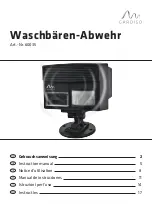
325
SECTION 34 - DIAGNOSTICS AND TROUBLESHOOTING
FORM 160.54-M1
ISSUE DATE: 10/25/2019
JOHNSON CONTROLS
JCI COMPANY CONFIDENTIAL
34
4. If the measured value is not within plus or mi-
nus 15% of the displayed value, replace the mi-
croboard. Otherwise, proceed to the trouble-
shooting procedure below to find the cause of the
problem.
5. When all desired tests have been performed, press
DIAGNOSTICS key to return the MAIN DIAG-
NOSTICS Screen.
Troubleshooting
All Channels except 0, 1, 15-22, 27, 28
1. Disconnect both ends of the cable of the Analog
Input that is malfunctioning. Using an Ohmmeter,
perform a continuity test on all conductors in the
cable. An open circuit would indicate the cable is
defective.
2. Using a Voltmeter, measure the +12 VDC supply
voltage input at the microboard J1-3 (+12 VDC)
to J1-2 (GND). If voltage is less than 11.5 VDC,
check wiring to Power Supply. If wiring is OK,
the Power Supply is most likely defective.
3. Using a Voltmeter, measure the supply voltage
(+5 VDC, +1 2 VDC or +24 VDC) to the sensor.
If voltage is not within plus or minus 10% of spec-
ified voltage, disconnect J7, J8 and J9 from the
microboard. This disconnects all analog devices
from the microboard. If the voltage increases to
the correct level, a Thermistor or Transducer is
shorted. Locate the shorted device and replace it.
If, after disconnecting the connectors the supply
voltage is still not within 10% of the specified
value, the voltage supply source (Microboard or
Power Supply) is most likely defective.
4. Verify sensor accuracy using appropriate test de-
vice. Replace the sensor if necessary.
Channels 15 - 22
1. Disconnect both ends of the ribbon cable connected
to Microboard J10. Using an Ohmmeter, perform a
continuity test on all conductors in the cable. An
open circuit would indicate the cable is defective.
2. Using a Voltmeter, measure the +12 VDC supply
voltage input at the microboard J1-3 (+12 VDC)
to J1-2 (GND). If the voltage is less than 11.5
VDC, check the wiring to Power Supply. If wiring
is OK, the Power Supply is most likely defective.
3. Using a Voltmeter, measure the +5 VDC supply
voltage to the Solid State Starter Logic Board or
CM-2 Board. Make measurement at Microboard
J10-4 (+5 VDC) to J10-5 (GND). If voltage is less
than 4.5 VDC, replace the microboard.
4. Using a Voltmeter, verify the correct address is
being sent from the microboard to the Solid State
Starter Logic Board or CM-2 Board. Freeze ad-
dress as described above. If the address is correct,
the Solid State Starter Logic Board or CM-2 Board
or input devices to these boards are most likely
the cause of the problem. If address is not cor-
rect, the microboard is most likely the cause of
the problem.
5. Press
CANCEL FREEZE
key.
Channels 27, 28
1. See
SECTION 3 - MICROBOARD 031-01730-
“Microboard Program Jumpers” and verify
Program Jumpers JP23 and JP24 are configured
correctly for the type of input (0 to 10 VDC or 4
to 20mA).
2. Disconnect both ends of the cable of the remote
input that is malfunctioning. Using an Ohmmeter,
perform a continuity check on all conductors in
the cable. An open circuit would indicate the cable
is defective.
3. If steps are OK, problem most likely is in the re-
mote device that supplies the remote signal.
















































